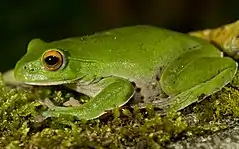| Rhacophoridae[1] | |||||
| Hoffman, 1932[2] | |||||
 Przedstawiciel rodziny – Rhacophorus moltrechti | |||||
| Systematyka | |||||
| Domena | |||||
|---|---|---|---|---|---|
| Królestwo | |||||
| Typ | |||||
| Podtyp | |||||
| Gromada | |||||
| Rząd | |||||
| Podrząd | |||||
| Rodzina |
nogolotkowate | ||||
| Typ nomenklatoryczny | |||||
|
Rhacophorus Kuhl & Van Hasselt, 1822 | |||||
| |||||
| Podrodziny | |||||
| |||||
Nogolotkowate[15], żaby latające[16] (Rhacophoridae) – rodzina płazów z rzędu płazów bezogonowych (Anura).
Zasięg występowania
Rodzina obejmuje gatunki występujące w Czarnej Afryce oraz południowej Azji od Sri Lanki, Nepalu i Indii po Japonię, Filipiny i Celebes w Indonezji[17].
Charakterystyka
Nogolotkowate mają powiększone błony pomiędzy palcami. Jednym z przedstawicieli jest nogolotka jawajska (Rhacophorus reinwardtii). Dzięki błonom pływnym sprawnie porusza się w koronach drzew lotem ślizgowym. W czasie lotu rozpłaszcza ciało, a rozstawione na boki kończyny zwiększają powierzchnię lotną.
Podział systematyczny
Do rodziny należą następujące podrodziny[17]:
- Buergeriinae Channing, 1989
- Rhacophorinae Hoffman, 1932
Uwagi
Przypisy
- ↑ Rhacophoridae, [w:] Integrated Taxonomic Information System (ang.).
- ↑ A.C. Hoffman. Researches relating to the validity of the South African Polypedatidae (Rhacophoridae) as an autonomous family of the Anura. „South African Journal of Science”. 29, s. 581, 1932. (ang.).
- ↑ A.L.C.G. Günther. On the systematic arrangement of the tailless batrachians and the structure of Rhinophrynus dorsalis. „Proceedings of the Zoological Society of London”. 26, s. 346, 1858. (ang.).
- ↑ S.G. Mivart. On the classification of the anurous batrachians. „Proceedings of the Zoological Society of London”. 1869, s. 292, 1869. (ang.).
- ↑ G.A. Boulenger. Note on the classification of the Ranidae. „Proceedings of the Zoological Society of London”. 1888, s. 205, 1888. (ang.).
- ↑ G.K. Noble. The value of life history data in the study of the evolution of the Amphibia. „Annals of the New York Academy of Sciences”. 30, s. 105, 1927. DOI: 10.1111/j.1749-6632.1927.tb55359.x. (ang.).
- ↑ R.F. Laurent. Contribution a l’étude des genres Megalixalus et Hyperolius. „Bulletin du Musée Royal d'Histoire Naturelle de Belgique”. 19, s. 16, 1943. (fr.).
- ↑ W. Hellmich. Herpetologische Ergebnisse einer Forschungsreise in Angola. „Veröffentlichungen der Zoologischen Staatssammlung München”. 5, s. 28, 1957. (niem.).
- ↑ A. Dubois. Liste des genres et sous-genres nominaux de Ranoidea (Amphibiens Anoures) du monde, avec identification de leurs espèces types; consequences nomenclaturales. „Monitore Zoologico Italiano”. Nuova Serie, Supplemento. 15, s. 258, 1981. DOI: 10.1080/03749444.1981.10736637. (fr.).
- ↑ A. Dubois. Miscellanea taxinomica batrachologica (I). „Alytes”. 5, s. 34, 69, 1986. (ang.).
- ↑ A. Channing. A re-evaluation of the phylogeny of Old World treefrogs. „South African Journal of Zoology”. 24 (2), s. 127, 1989. (ang.).
- ↑ Dubois 1992 ↓, s. 335.
- ↑ Dubois 1992 ↓, s. 336.
- 1 2 S. Grosjean, M. Delorme, A. Dubois & A. Ohler. Evolution of reproduction in the Rhacophoridae (Amphibia, Anura). „Journal of Zoological Systematics and Evolutionary Research”. 46 (2), s. 174, 2008. DOI: 10.1111/j.1439-0469.2007.00451.x. (ang.).
- ↑ Praca zbiorowa: Zwierzęta: encyklopedia ilustrowana. Warszawa: Wydawnictwo Naukowe PWN, 2005, s. 382. ISBN 83-01-14344-4.
- ↑ W. Juszczyk: Gady i płazy. Wyd. 2. Warszawa: Wiedza Powszechna, 1986, s. 280, seria: Mały słownik zoologiczny. ISBN 83-214-0043-4.
- 1 2 D. Frost: Rhacophoridae Hoffman, 1932 (1858). [w:] Amphibian Species of the World 6.0, an Online Reference [on-line]. American Museum of Natural History. [dostęp 2020-02-08]. (ang.).
Bibliografia
- A. Dubois. Notes sur la classification des Ranidae (Amphibiens anoures). „Bulletin Mensuel de la Société Linnéenne de Lyon”. 61, s. 305–352, 1992. (fr.).
- Zwierzęta: encyklopedia ilustrowana. Warszawa: Wydawnictwo Naukowe PWN, 2005. ISBN 83-01-14344-4.
This article is issued from Wikipedia. The text is licensed under Creative Commons - Attribution - Sharealike. Additional terms may apply for the media files.